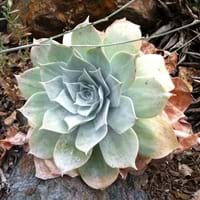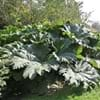Life Span
Perennial
Perennial
Origin
Hybrid origin
Western United States, Mexico
Types
Victoria Rhubarb
Colorado Red Rhubarb
Turkish Rhubarb
Dudleya brittonii
Dudleya pulverulenta
Dudleya farinosa
Dudleya caespitosa
Dudleya virens
Habitat
gardens, Grassland, Humid climates, Tropical regions, Urban areas
Barren waste areas, Semi arid regions, Semi desert
USDA Hardiness Zone
5-8
Not Available
Sunset Zone
2b, 3a, 3b, 4, 5, 6, 7, 14, 15, 16, 17
Not Available
Habit
Clump-Forming
Rosette/Stemless
Flower Color
Light Pink
White, Yellow, Red, Pink
Flower Color Modifier
Not Available
Not Available
Fruit Color
Burgundy
Non Fruiting Plant
Leaf Color in Spring
Green, Dark Red
Green, Gray
Leaf Color in Summer
Green, Dark Red
Green, Gray
Leaf Color in Fall
Green, Dark Red
Green, Gray
Leaf Color in Winter
Light Green
Green, Gray
Leaf Shape
Compound
Acuminate
Plant Season
Spring, Summer, Fall
Spring, Summer, Fall, Winter
Sunlight
Full Sun, Partial Sun
Full Sun
Growth Rate
Medium
Medium
Type of Soil
Clay, Loam
Sand
The pH of Soil
Acidic, Neutral, Alkaline
Neutral
Soil Drainage
Average
Well drained
Bloom Time
Summer, Late Summer
Summer
Tolerances
Drought
Drought
Where to Plant?
Ground
Ground
How to Plant?
Stem Planting
Cuttings, Stem Cutting
Plant Maintenance
Medium
Medium
Watering Requirements
Do Not over Water, Requires regular watering, Use Mulches to help prevent water loss during hot and windy weather, Water Deeply
Allow soil to be completely dry in between waterings, Needs less watering
In Summer
Lots of watering
Lots of watering
In Spring
Moderate
Moderate
In Winter
Average Water
Average Water
Soil pH
Acidic, Neutral, Alkaline
Neutral
Soil Type
Clay, Loam
Sand
Soil Drainage Capacity
Average
Well drained
Sun Exposure
Full Sun, Partial Sun
Full Sun
Pruning
Remove damaged leaves, Remove dead branches, Remove dead leaves
Remove damaged leaves, Remove dead branches, Remove dead leaves, Remove dead or diseased plant parts
Fertilizers
All-Purpose Liquid Fertilizer
No fertilizers needed
Pests and Diseases
Red blotch
Cochineal insect, Mealybugs, Nematodes, Red blotch, Rodent, Scale insects
Plant Tolerance
Drought
Drought, Dry Conditions, Dry soil, Full Sun, Shade areas
Flower Petal Number
Not Available
Single
Foliage Texture
Coarse
Bold
Foliage Sheen
Glossy
Matte
Attracts
Not Available
Hummingbirds, Butterflies
Allergy
Skin irritation
Not Available
Aesthetic Uses
Showy Purposes
Not Used For Aesthetic Purpose
Beauty Benefits
Not Available
Not Available
Edible Uses
Yes
Not Available
Environmental Uses
Air purification
Air purification
Medicinal Uses
Not Available
Not Available
Part of Plant Used
Whole plant
Leaves
Other Uses
Culinary use, Used as Ornamental plant
Not Available
Used As Indoor Plant
No
No
Used As Outdoor Plant
Yes
Yes
Garden Design
Feature Plant, Mixed Border
Container, Houseplant, Mixed Border, Rock Garden, Wall
Botanical Name
RHEUM 'Ace of Hearts'
DUDLEYA
Common Name
Ace of Hearts Ornamental Rhubarb, Ornamental Rhubarb
Chalk Lettuce
Chalk dudleya
In Hindi
सजावटी प्रकार का फल
Dudleya
In German
Ornamental Rhabarber
Dudleya
In French
rhubarbe ornementale
Dudleya
In Spanish
Ornamental de ruibarbo
dudleya
In Greek
καλλωπιστικά Ραβέντι
Dudleya
In Portuguese
ornamental ruibarbo
Dudleya
In Polish
ozdobne Rabarbar
Dudleya
In Latin
decentius Rhubarb
Dudley
Phylum
Tracheophyta
Tracheophyta
Class
Not Available
Magnoliopsida
Order
Caryophyllales
Saxifragales
Family
Polygonaceae
Crassulaceae
Clade
Angiosperms, Core eudicots, Eudicots
Angiosperms, Core eudicots, Eudicots
Tribe
Not Available
Not Available
Subfamily
Not Available
Not Available
Difference Between Ornamental Rhubarb and Dudleya
If you are confused whether Ornamental Rhubarb or Dudleya are same, here are some features about those plants to help you choose better. Many people think that these two plants have the same characteristics, but one can see Ornamental Rhubarb and Dudleya Information and learn more about it. Fertilizers required for proper growth of Ornamental Rhubarb are All-Purpose Liquid Fertilizer, whereas for Dudleya fertilizers required are No fertilizers needed. Hence, one should know the basic difference between Ornamental Rhubarb and Dudleya if you are planning to have them in your garden to enhance its beauty.
<
Flowering PlantsImportance of Ornamental Rhubarb and Dudleya
Want to have the most appropriate plant for your garden? You might want to know the importance of Ornamental Rhubarb and Dudleya. Basically, these two plants vary in many aspects. Compare Ornamental Rhubarb and Dudleya as they differ in many characteristics such as their life, care, benefits, facts, etc. Every gardener must at least have the slightest clue about the plants he wants to plant in his garden. Compare their benefits, which differ in many ways like facts and uses. The medicinal use of Ornamental Rhubarb is Not Available whereas of Dudleya is Not Available. Ornamental Rhubarb has beauty benefits as follows: Not Available while Dudleya has beauty benefits as follows: Not Available.
Compare Facts of Ornamental Rhubarb vs Dudleya
How to choose the best garden plant for your garden depending upon its facts? Here garden plant comparison will help you to solve this query. Compare the facts of Ornamental Rhubarb vs Dudleya and know which one to choose. As garden plants have benefits and other uses, allergy is also a major drawback of plants for some people. Allergic reactions of Ornamental Rhubarb are Skin irritation whereas of Dudleya have Not Available respectively. Having a fruit bearing plant in your garden can be a plus point of your garden. Ornamental Rhubarb has showy fruits and Dudleya has no showy fruits. Also Ornamental Rhubarb is not flowering and Dudleya is not flowering . You can compare Ornamental Rhubarb and Dudleya facts and facts of other plants too.





